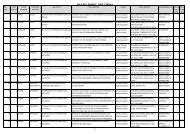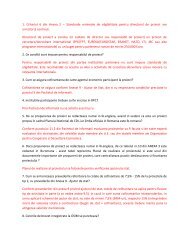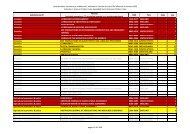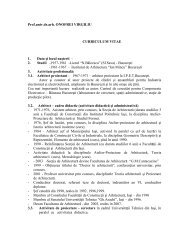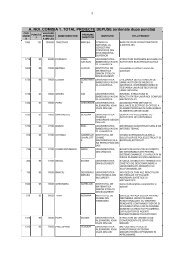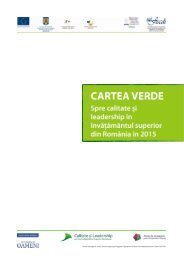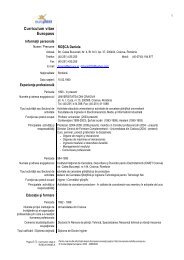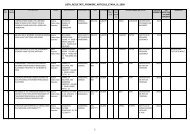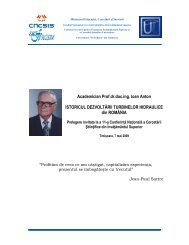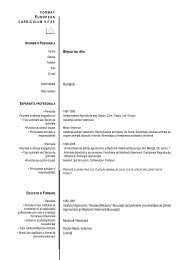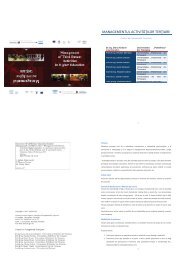- Page 2 and 3:
EditorsAdrian Curaj & Katja PookAut
- Page 4 and 5:
ForewordTen years after the first i
- Page 6 and 7:
List of contentsWhat can be expecte
- Page 8 and 9:
Category Reg.2: Political environme
- Page 10 and 11:
Jobs.2.7: Spending on HR by type of
- Page 12 and 13:
Eco.4.2: Initiatives to reduce poll
- Page 14 and 15:
TempEco.Int: Interview GuidelineTem
- Page 16 and 17:
Assessing RIs in Europe - the polic
- Page 18 and 19:
A simple, but important distinction
- Page 20 and 21:
The role of RIs beyond scientific i
- Page 22 and 23:
• A structured exploration of the
- Page 24 and 25:
Figure 1: Roles and an example of t
- Page 26 and 27:
FenRIAM consists of eight modules c
- Page 28 and 29:
try or the European Union as whole.
- Page 30 and 31:
Scoping - UC3The two most important
- Page 32 and 33:
Scoping - UC5The ex-ante estimation
- Page 34 and 35:
Category RI.1: Scientific Backgroun
- Page 36 and 37:
RI.1.2: Key scientific fields for u
- Page 38 and 39:
Category RI.2: Technical Performanc
- Page 40 and 41:
RI.2.2: Technical performance of th
- Page 42 and 43:
Category RI.3: Competing and Comple
- Page 44 and 45:
RI.3.2: Planned facilities of the s
- Page 46 and 47:
Category RI.4: Investor Consortium
- Page 48 and 49:
RI.4.2: Facility SiteRelevance:The
- Page 50 and 51:
RI.4.4: Motivations and expectation
- Page 52 and 53:
Category RI.5: Project Budget and C
- Page 54 and 55:
RI.5.2: Available construction fund
- Page 56 and 57:
RI.5.4: Available operation funds a
- Page 58 and 59:
Category RI.6: Scientific Activitie
- Page 60 and 61:
RI.6.2: R&D strategy and strategic
- Page 62 and 63:
RI.6.4: Strategy and resources for
- Page 64 and 65:
RI.6.6: Strategy and resources for
- Page 66 and 67:
Category RI.7: Procurement and Sale
- Page 68 and 69:
RI.7.2: Procurement process and pro
- Page 70 and 71:
RI.7.4: Industrial sectors and mark
- Page 72 and 73:
Category RI.8: Public RelationsHow
- Page 74 and 75:
Category RI.9: Human ResourcesHow w
- Page 76 and 77:
RI.9.2: HR planning and recruitment
- Page 78 and 79:
RI.9.4: Mean salary level by occupa
- Page 80 and 81:
Module Regio - Regional ProfileDivi
- Page 82 and 83:
Reg.1.1: Centrality, borders, and c
- Page 84 and 85:
Category Reg.2: Political environme
- Page 86 and 87:
Reg.2.2: Administrative organisatio
- Page 88 and 89:
Category Reg.3: Legal framework con
- Page 90 and 91:
Reg.3.2: Effectiveness/efficiency o
- Page 92 and 93:
Reg.3.4: Taxation and feesRelevance
- Page 94 and 95:
Reg.4.1: IT infrastructures and ser
- Page 96 and 97:
Reg.4.3: General suppliesRelevance:
- Page 98 and 99:
Category Reg.5: Labour marketWhat a
- Page 100 and 101:
Reg.5.2: Wages, pension policyRelev
- Page 102 and 103:
Category Reg.6: Regional economyWha
- Page 104 and 105:
Reg.6.2: Economic performance and c
- Page 106 and 107:
Reg.7.1: Existing research faciliti
- Page 108 and 109:
Reg.7.3: Educational systemRelevanc
- Page 110 and 111:
Figure 8: The RI impact as a differ
- Page 112 and 113:
System Analysis - UC2In the case of
- Page 114 and 115:
Suggested procedure for success sce
- Page 116 and 117:
Figure 10. The RI impact as differe
- Page 118 and 119:
System Analysis - UC4In the case of
- Page 120 and 121:
Impact AssessmentModule S+T: Scienc
- Page 122 and 123:
S+T.1.1: Services and opportunities
- Page 124 and 125:
S+T.1.3: Access and maintenance tim
- Page 126 and 127:
S+T.1.5: Monetary value of offered
- Page 128 and 129:
S+T.2.1: Publications (all types)Re
- Page 130 and 131:
S+T.2.3: New standards and procedur
- Page 132 and 133:
Category S+T.3: Innovation OutcomeH
- Page 134 and 135:
S+T.3.2: Instruments and productsRe
- Page 136 and 137:
Category S+T.4: Networking & Collab
- Page 138 and 139:
S+T.4.2: Research contracts & proje
- Page 140 and 141:
S+T.4.4: Organised scientific event
- Page 142 and 143:
S+T.4.6: Major networks with indust
- Page 144:
Category S+T.5: Impact on Suppliers
- Page 147 and 148:
S+T.5.3: High-tech contracts and ut
- Page 149 and 150:
S+T.5.5: Low-tech contractsRelevanc
- Page 151 and 152:
Category S+T.6: More impacts on fir
- Page 153 and 154:
S+T.6.2: Customers and contractsRel
- Page 155 and 156:
S+T.6.4: RevenuesRelevance:This ind
- Page 157 and 158:
S+T.6.6: Scientific papers cited in
- Page 159 and 160:
Module Jobs: Work & PopulationModul
- Page 161 and 162:
Jobs.1.1: Generated economic effect
- Page 163 and 164:
Jobs.2.1: HR by occupation category
- Page 165 and 166:
Jobs.2.3: Recruitment markets by oc
- Page 167 and 168:
Jobs.2.5: Type of contract by gende
- Page 169 and 170:
Jobs.2.7: Spending on HR by type of
- Page 171 and 172:
Category Jobs.3: Indirectly Created
- Page 173 and 174: Jobs.3.2: Jobs created in spin-offs
- Page 175 and 176: Category Jobs.4: Training of Studen
- Page 177 and 178: Jobs.4.2: Nationality of trained st
- Page 179 and 180: Jobs.4.4: Resources for research tr
- Page 181 and 182: Jobs.4.6: Events for studentsReleva
- Page 183 and 184: Category Jobs.5: Training of Scient
- Page 185 and 186: Jobs.5.2: Scientific and technical
- Page 187 and 188: Jobs.5.4: Expected impact of scient
- Page 189 and 190: Jobs.6.1: General training programm
- Page 191 and 192: Jobs.6.3: Annual Spending on Genera
- Page 193 and 194: Category Jobs.7: Labour MarketWhat
- Page 195 and 196: Jobs.7.2: Long-term impact on jobs
- Page 197 and 198: Jobs.7.4: Long-term impact on salar
- Page 199 and 200: Category Jobs.8: PopulationWhat is
- Page 201 and 202: Jobs.8.2: Long-term Impact on Educa
- Page 203 and 204: Jobs.8.4: Expected population trend
- Page 205 and 206: Category Life.1: HealthWhich influe
- Page 207 and 208: Life.1.2: Benefits for societyRelev
- Page 209 and 210: Life.1.4: Impact on health care wor
- Page 211 and 212: Category Life.2: EducationHow do ed
- Page 213 and 214: Life.2.2: Changes of education infr
- Page 215 and 216: Life.2.4: Challenges on the skills
- Page 217 and 218: Category Life.3: CultureHow does th
- Page 219 and 220: Life.3.2: Effects on socio-cultural
- Page 221 and 222: Life.3.4: Significant additional de
- Page 223: Category Life.4: Lifestyle and soci
- Page 227 and 228: Life.4.4: Long-term effect on the q
- Page 229 and 230: Category Eco.1: EnergyWhat energy i
- Page 231 and 232: Eco.1.2: Specific requirements on t
- Page 233 and 234: Eco.1.4: Initiatives for a sustaina
- Page 235 and 236: Category Eco.2: Water & EffluentsWh
- Page 237 and 238: Eco.2.2: Type, quantity, and effect
- Page 239 and 240: Eco.2.4: Effects on water supply an
- Page 241 and 242: Eco. 2.6: New knowledge, methods, t
- Page 243 and 244: Eco.3.1: Quantity of waste by type
- Page 245 and 246: Eco.3.3: Type and quantity of handl
- Page 247 and 248: Eco.3.5: New knowledge, methods, te
- Page 249 and 250: Eco.4.1: Type, quantity, and effect
- Page 251 and 252: Eco.4.3: Type, level, and effects o
- Page 253 and 254: Eco.4.5: Impacts on light and light
- Page 255 and 256: Category Eco.5: RadiationWhat radia
- Page 257 and 258: Eco.5.2: Radiation risks, radiation
- Page 259 and 260: Category Eco.6: Biodiversity & Habi
- Page 261 and 262: Eco.6.2: Expected impacts of RI act
- Page 263 and 264: Category Eco.7: Environmental Aware
- Page 265 and 266: Eco.7.2: Impacts on environmental a
- Page 267 and 268: Category Risk.1: Financial RisksWhi
- Page 269 and 270: Risk.1.2: Financial risks for RI co
- Page 271 and 272: Risk.1.4: Financial risks for RI up
- Page 273 and 274: Category Risk.2: Public Acceptance
- Page 275 and 276:
Risk.2.2: Risk for a lack of public
- Page 277 and 278:
Risk.3.1: Supply risks for RI const
- Page 279 and 280:
Risk.3.3: Supply risks for RI upgra
- Page 281 and 282:
Category Risk.4: External Risks for
- Page 283 and 284:
Risk.4.2: Geological and hydro-geol
- Page 285 and 286:
Risk.4.4: Data security risksReleva
- Page 287 and 288:
Risk.5.1: Ecological risks during c
- Page 289 and 290:
Risk.5.3: Ecological risks during o
- Page 291 and 292:
Risk.5.5: Ecological risks during u
- Page 293 and 294:
Risk.5.7: Ecological risks during d
- Page 295 and 296:
Alternative ScenariosIn this chapte
- Page 297 and 298:
Preparatory workPrior to the Altern
- Page 299 and 300:
Guidelines for the Alternative Scen
- Page 301 and 302:
Selecting two drivers and building
- Page 303 and 304:
Examining wild cards effectsExamini
- Page 305 and 306:
ReportingThe final report of FenRIA
- Page 307 and 308:
Annex I: Templates for module S+TTh
- Page 309 and 310:
TempS+T.2.1: Selection of data coll
- Page 311 and 312:
TempS+T.3.1: Selection of data coll
- Page 313 and 314:
TempS+T.4.2: Selection of data coll
- Page 315 and 316:
TempS+T.5.2: Selection of data coll
- Page 317 and 318:
TempS+T.6.2: Selection of data coll
- Page 319 and 320:
S+T.1: User ServicesS+T.1.1: Servic
- Page 321 and 322:
S+T.3: InnovationS+T.3.1: Intellect
- Page 323 and 324:
S+T.5: Impacts on SuppliersS+T.5.1:
- Page 325 and 326:
TempS+T.Int: Interview GuidelineQue
- Page 327 and 328:
S+T.3: InnovationsS+T.3.1Question:H
- Page 329 and 330:
S+T.4.6Question:In which major netw
- Page 331 and 332:
S+T.5.4Question:Which further impac
- Page 333 and 334:
S+T.6.5Question:Which major researc
- Page 335 and 336:
Geographical area Host country EU m
- Page 337 and 338:
S+T.3: InnovationNameTypeIPR1S+T.3.
- Page 339 and 340:
Facility scientists as host scienti
- Page 341 and 342:
No. of contracts awarded to low-tec
- Page 343 and 344:
Industrial users and user companies
- Page 345 and 346:
Input-Output Method Step-by-StepInp
- Page 347 and 348:
Annex II: Templates for module EcoT
- Page 349 and 350:
TempEco.2.1: Category Eco.2 - Selec
- Page 351 and 352:
TempEco.4.1: Category Eco.4 - Selec
- Page 353 and 354:
TempEco.6.1: Category Eco.6 - Selec
- Page 355 and 356:
TempEco.Doc: Document Analysis Temp
- Page 357 and 358:
Eco.3: Materials & WasteEco.3.1: Qu
- Page 359 and 360:
Eco.5: RadiationEco.5.1: Type, leve
- Page 361 and 362:
TempEco.Int: Interview GuidelineQue
- Page 363 and 364:
Eco.2.3Question:What are the specif
- Page 365 and 366:
Eco.4: Emissions & NoiseEco.4.1Ques
- Page 367 and 368:
Eco.5.3Question:Are there any new d
- Page 369 and 370:
TempEco.Qu: Questionnaire (Please a
- Page 371 and 372:
Eco.3: Materials and WasteEco.3.1Qu
- Page 373 and 374:
TempRisk.1.1: Selection of data col
- Page 375 and 376:
TempRisk.3.1: Selection of data col
- Page 377 and 378:
TempRisk.5.1: Selection of data col
- Page 379 and 380:
TempRisk.Doc: Document Analysis Tem
- Page 381 and 382:
TempRiskDoc.4.1: External Risks for
- Page 383 and 384:
TempRisk.Int: Interview Guideline (
- Page 385 and 386:
Risk.4: External Risks for the Proj
- Page 387 and 388:
Temp RiskSupp: Interview Support Te
- Page 389 and 390:
RiskScale.2: Severity of EventsThis
- Page 391 and 392:
RiskMatrix: Risk Level DefinitionTh



